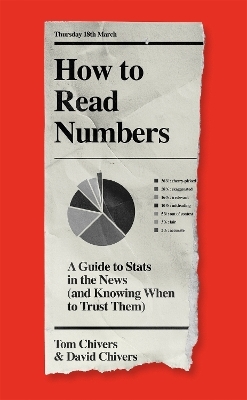
How to Read Numbers
Weidenfeld & Nicolson (Verlag)
978-1-4746-1996-7 (ISBN)
- Titel ist leider vergriffen;
keine Neuauflage - Artikel merken
'Even one glass of wine a day raises the risk of cancer'
'Hate crimes have doubled in five years'
'Fizzy drinks make teenagers violent'
Every day, most of us will read or watch something in the news that is based on statistics in some way. Sometimes it'll be obvious - 'X people develop cancer every year' - and sometimes less obvious - 'How smartphones destroyed a generation'. Statistics are an immensely powerful tool for understanding the world; the best tool we have. But in the wrong hands, they can be dangerous.
This book will help you spot common mistakes and tricks that can mislead you into thinking that small numbers are big, or unimportant changes are important. It will show you how the numbers you read are made - you'll learn about how surveys with small or biased samples can generate wrong answers, and why ice cream doesn't cause drownings.
We are surrounded by numbers and data, and it has never been more important to separate the good from the bad, the true from the false. HOW TO READ NUMBERS is a vital guide that will help you understand when and how to trust the numbers in the news - and, just as importantly, when not to.
Tom Chivers is a science writer and author. He was awarded the Royal Statistical Society 'statistical excellence in journalism' award in 2018, and was highly commended for the same prize in 2017; he has also been shortlisted for the Association of British Science Writers award and a British Journalism Award in science writing, and won the American Psychological Society media award, all in 2017. His first book, The AI Does Not Hate You: Superintelligence, Rationality and the Race to Save the World, was declared one of The Times' science books of 2019. David Chivers is an assistant professor of economics at Durham University. Before this post he was a lecturer at the University of Oxford and completed his PhD at the University of Manchester, funded by the ESRC. He has published in academic journals such as Review of Economic Dynamics, Economic Theory and Journal of Economic Behaviour and Organisation. His research interests involve topics relating to inequality, growth and development.
| Erscheinungsdatum | 19.03.2021 |
|---|---|
| Verlagsort | London |
| Sprache | englisch |
| Maße | 142 x 222 mm |
| Gewicht | 328 g |
| Themenwelt | Sachbuch/Ratgeber ► Natur / Technik |
| Mathematik / Informatik ► Mathematik ► Mathematische Spiele und Unterhaltung | |
| ISBN-10 | 1-4746-1996-7 / 1474619967 |
| ISBN-13 | 978-1-4746-1996-7 / 9781474619967 |
| Zustand | Neuware |
| Haben Sie eine Frage zum Produkt? |
aus dem Bereich


